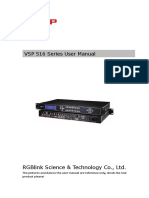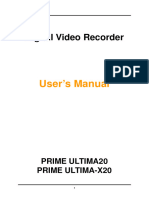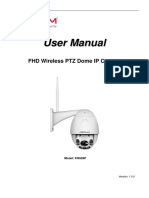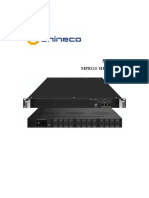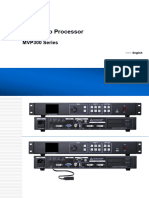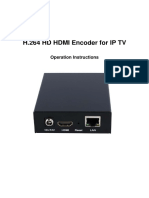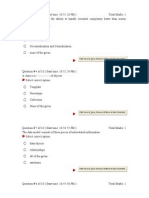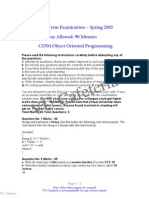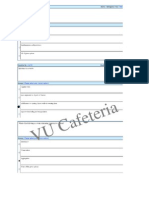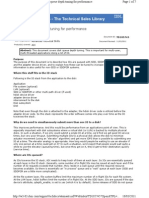Manual For DVR-9316 LONGSE (01.10.06.01.187)
Manual For DVR-9316 LONGSE (01.10.06.01.187)
Uploaded by
sny2ksaCopyright:
Available Formats
Manual For DVR-9316 LONGSE (01.10.06.01.187)
Manual For DVR-9316 LONGSE (01.10.06.01.187)
Uploaded by
sny2ksaOriginal Title
Copyright
Available Formats
Share this document
Did you find this document useful?
Is this content inappropriate?
Copyright:
Available Formats
Manual For DVR-9316 LONGSE (01.10.06.01.187)
Manual For DVR-9316 LONGSE (01.10.06.01.187)
Uploaded by
sny2ksaCopyright:
Available Formats
H.
264 NETWORK
Embedded DVR
USER MANUAL
H.264
To reset the password Enter the master password
020818 and then enter the new password
2
3
CONTENT
1 INTRODUCTION ............................................................................................................................................ 4
1.1 PRODUCT INTRODUCTION .............................................................................................................. 4
1.2 PRODUCT FEATURE .......................................................................................................................... 4
1.2.1 SPECIFICATION .............................................................................................................................. 4
1.2.2 BASIC WORKING PARAMETER .................................................................................................. 5
1.3 ENVIRONMENT ADAPTABILITY .................................................................................................... 6
2 DEVICE OPERATION .................................................................................................................................. 7
2.1 REMOTE KEY INSTRUCTION ........................................................................................................... 7
2.1.1 REMOTE CONTROL ....................................................................................................................... 7
2.1.2 MOUSE OPERATION ...................................................................................................................... 8
2.1.3 MENU TREE .................................................................................................................................... 9
2.2 SYSTEM OPERATION ...................................................................................................................... 10
2.2.1 USER LOGIN .................................................................................................................................. 10
2.2.2 USING THE MAIN MENU ............................................................................................................ 11
2.2.3 DEVICES MANAGEMENT ........................................................................................................... 19
2.2.4 SYSTEM SETUP ............................................................................................................................ 25
3 IE OPERATION .......................................................................................................................................... 29
3.1 FEATURE ........................................................................................................................................... 29
3.2 USING REMOTE SURVEILLANCE ................................................................................................. 30
3.3 REMOTE SURVEILLANCE MAIN SCREEN ................................................................................... 31
3.4 LIVE VIEWING .................................................................................................................................. 32
3.5 RECORDING ...................................................................................................................................... 32
3.5.1 SUB-MENU .................................................................................................................................... 32
3.5.2 PTZ CONTROL .............................................................................................................................. 33
3.5.3 SCREEN CAPTURES ..................................................................................................................... 33
3.5.4 PLAYBACK .................................................................................................................................... 33
3.6 REMOTE SETUP ................................................................................................................................ 35
3.6.1 RECORD ......................................................................................................................................... 35
3.6.2 ALARM SETTING ......................................................................................................................... 36
3.6.3 PTZ .................................................................................................................................................. 37
3.6.4 NETWORK ..................................................................................................................................... 37
3.6.5 SETTING ......................................................................................................................................... 38
3.6.7 HOST INFO .................................................................................................................................... 39
4 DVR INSTALLATION ............................................................................................................................... 40
4.1 PRODUCT OVERVIEW ..................................................................................................................... 40
4.2 HDD INSTALLATION ....................................................................................................................... 43
5 FAQ .............................................................................................................................................................. 44
4
1 INTRODUCTION
1.1 PRODUCT INTRODUCTION
This product is a 16 channels CIF resolution Digital Video Recorder which has local
recording, playback, support triple code remote network surveillance, data backup, parameter
setting, motion detection, I/O alarm setting, PTZ, USB mouse, USB2.0 data backup, IE browser
and back up.
1.2 PRODUCT FEATURE
H.264 compression
Two USB interface, USB2.0 for data backup, USB1.1 for mouse operation.
Supports 2 pcs 3.5 SATA HDD
Special file system for security
16 bit color translucent user-friendly GUI, with notes for selected menu items.
Optimized 16 channel simultaneously playback
Double level user management
Supports live view, parameter setting and copy playback video via network.
1.2.1 SPECIFICATION
Item Device Performance index
System
Language English /Chinese
GUI Graphic menu
password user password, administrator password
Video
Video in
16ch composite video input 1.0V
p-p,impedance75,BNC
Video out
2ch complex video output 1.0V
p-p,impedance75,BNC
Video display 1/4/9/16 switch
Video standard
PAL,25f/s,CCIR625line,50scene
NTSC,30f/s,CCIR525line,60scene
Audio
Audio input 16ch audio input, impedance 600,RCA
Audio output 1ch audio output, impedance 600,RCA
Basic electricity
output
Linearity electricity
Record style Audio video recorded simultaneously
Audio
compression
ADPCM
Picture
proceeding
and store
Picture
compression
H.264
Resolution CIF
5
Streaming style ISO14496-10
Audio style ADPCM
Video code rate
CIF: 384~768 Kbps(optional)
HD1:512~1024Kbps(optional)
D1:512~1024Kbps(optional)
Audio code rate 32KB/s
Data storage Support mainstream SATA HDD
Alarm
Alarm input 16 alarm input
Alarm output 1 alarm output
Connector
Serial interface Support 1 RS232
Serial interface Support 1 RS485
Network interface RJ45,10M/100M
USB
Mouse USB1.1
Thumb drive USB2.0
VGA VGA output
Support 800x600,1024x768,1280x1024,1366x768,
1440 x900 resolution
HDMI HDMI output Support 720P,1080I,1080P
Software PC playback Playback video file
Software upgrade Support USB firmware upgrade
Others
Voltage input AC:110~240V
Power 16W without HDD
Working
temperature
-10----50
1.2.2 BASIC WORKING PARAMETER
Item Parameter Description
Voltage input 12V DC 12V
Video impedance
input
75 75 each channel.
Video output 1Vp-p 1Vp-p CVBS signal
I/O
02V Low voltage alarm
5V-30v High voltage alarm
RS232 Serial port, for extend use
RS485 Connects to PTZ, (Pelco-D,Pelco-P)
SATA HDD 4 SATA HDD with mainstream capacity
6
1.3 ENVIRONMENT ADAPTABILITY
For safety while using the DVR and to prolong device life, please pay attention to the
following details
1) When installing device, please comply with all the electric product safety criteria.
2) Power and ground:
Do not touch the power and DVR with a wet hand
Do not drop liquid on DVR
Do not put any object on DVR
Please use soft dry cloth to clean DVR; do not use chemical impregnant.
The Device will have voltage before startup if the power line is connected to power source.
Please unplug power line from power source if the Device is not intended to be used
for a prolonged time.
7
2 DEVICE OPERATION
In device operation, the enter key on remote control has the same function as left click of the
mouse.
2.1 REMOTE KEY INSTRUCTION
2.1.1 REMOTE CONTROL
The remote control is the secondary input device
for navigating the systems interface.
To use the remote control:
1. STANDBY: Press to turn standby mode ON/OFF.
2. LOGIN/LOCK: If "Security" has been enabled in the
Setup menu, press to open the user password login
screen.
3. Number/Channel buttons: While in menus,
press button 0~9 to enter values; during live
view, press to view channel in full-screen.
4. : Press to switch between quad and
split-screen displays.
5. MENU: Opens the main menu.
6. PTZ: Press to open the PTZ control window.
7. EXIT: Close menu windows.
8. Navigation/OK:
/CH+: Move cursor in menus up; Channel Up.
/FWD: Move cursor in menus right; during
playback, increase forward playback speed (5X, 15X,
60X).
/REW: Move cursor in menus left; during playback,
increase reverse playback speed (5X, 15X, 60X)
/CH-: Move cursor in menus down; Channel down.
OK: In menus, press to confirm selections; during
playback and preview, press to view system
information.
9. +/ - : In menus, press to adjust values.
10. RECORD: Press to start manual recording.
11. STOP: Press to stop manual recording.
12. EXTRA: For future use.
13. Playback controls:
: Increase reverse playback speed 1X, 2X, 4X.
: Press to start playback.
: Press to increase forward playback speed 1X, 2X, 4X.
: Press to slow playback speed by 1/2, 1/4, 1/8.
: Press to freeze playback to one frame, then press again to advance frame-by-frame.
TIP: When using the remote control
to enter password and camera
titles, select the field using the
navigation buttons, press ENTER,
and then press the number
buttons.
8
2.1.2 MOUSE OPERATION
The mouse is the primary input device for navigating system menus.
NOTE: Unless otherwise noted, all system functions described in this manual are achieved
through mouse input.
To use a mouse with the system:
1) Connect a USB mouse to the USB MOUSE port on front panel of the system.
NOTE: Only the top USB port on the front panel is designed for data backup to a USB flash
drive. Do not connect a USB flash drive to the bottom USB port on the rear panel.
Figure 1.0 Connect a USB mouse to the bottom USB port on the front panel
2) Use the mouse buttons to perform the following:
Left-Button: Click to select a menu option;
during live viewing in split-screen, double-click
on a channel to view the selected channel in
full-screen.; double-click the channel again to
return to split-screen view
Right-Button: Click to open the Sub-Menu
3) Scroll-Wheel: No function.
Figure 1.1 Mouse button operation
9
2.1.3 MENU TREE
You can control the DVR via menu operation. This tree will show you the menu structure
and details will be shown in following chapters.
10
2.2 SYSTEM OPERATION
2.2.1 USER LOGIN
2.2.1.1 STARTING THE SYSTEM
To power the system ON/OFF:
Connect the power cable to the DC 12V port on the rear panel. At startup, the system
performs a basic system check and runs an initial loading sequence. After a few moments, the
system loads a live display view.
Standby Mode
The system can also be put into Standby Mode. Power will remain to the system but will
not be recording.
To start/stop Standby mode:
1) Press and hold the POWER button on the front panel or remote control until the prompt
closes. The system enters standby mode.
2) Press and hold the POWER button on the front panel or remote control until the system
beeps. The system will begin powering up.
Password
ATTENTION: By default, passwords are disabled on the system. You do not need to enter
a password when accessing any system menus. However, for security purposes, it is highly
recommended to enable passwords on the system using the Password Menu.
NOTE:
1) If there is no HDD in device, or the device cannot read the HDD, or the HDD is not
formatted it will display anHin the video preview interface.
2) You must format the HDD in the DVR before use. The steps are as follows: menu >
HDD management > format. After formatting, the system will restart.
2.2.1.2 SYSTEM LOGIN
To open the Main Menu:
Right-click anywhere onscreen to open the Sub-Menu and select MAIN MENU (mouse only),
or press the LOGIN/LOCK button on the remote control.
NOTE: If passwords are enabled on the system, you need to select your Device ID and
enter the 6-digit numerical password to open the Main Menu.
11
2.2.2 USING THE MAIN MENU
1) CAMERA: Configure video display settings.
2) RECORD: Configure recording parameters (quality, resolution), set record modes, and
enable/disable audio recording.*
3) NETWORK: Use the Network Setup menu to configure your network and DDNS settings.
4) SEARCH: Search and playback recorded video on your system.
5) DEVICES: Opens the DEVICES Menu, which lets you setup the HDD, alarm, PTZ,
mobile and motion detect.
6) SYSTEM: Opens the DEVICES Menu, which lets you setup the date/time, password,
video/audio, language, info and maintain.
7) Displays information about the contents of the selected Main Menu icon.
*Audio capable cameras (not included) are required for audio recording on the system.
2.2.2.1 CAMERA
Use the Display Setup menu to customize channel titles, show/hide the date and time in live
viewing and playback, and enable/disable preview channels.
To customize Display settings:
1) Configure the following options:
12
TITLE: Click any of the fields and enter a new title for the selected channel using the
Virtual Keyboard (mouse only)
POSITION: Reposition the channel title; select U-L/D-L/U-R/D-R, or OFF. If OFF, the
title will not be displayed for the selected channel
COLOR: Adjust CHROMATICITY, LUMINOSITY, CONTRAST, and SATURATION
for the selected channel
DISPLAY TIME WHILE IN LIVE VIEW: Select ON/OFF to show/ hide the date and
time during live viewing
DISPLAY TIME WHILE RECORDING: Select ON/OFF to show/hide the date and
time during playback.
2) Click NEXT PAGE to change the settings for the remaining channels.
3 Click APPLY to save your settings. Click CLOSE in the confirmation window.
LIVE
Live channels can be very useful if your display monitor is in public view. Select OFF of a
preview channel will appear black on the display to give the impression that no cameras are
connected and the system is not recording.
To enable/disable preview channels:
1 Choose a channel you wish to conceal. For example, channel 3. Under PREVIEW,
select OFF.
2 Click APPLY. Channel 3 will turn black. Click CLOSE in the confirmation window.
3 Click EXIT in all menus until al windows are closed.
2.2.2.2 RECORD SETUP
Configure record parameters, enable/disable audio.
NOTE: Audio capable cameras (not included) are required for audio recording.
To configure recording options:
1) Under RECORD, use the drop-down menus and select ON/OFF to enable/disable
recording from the selected channel.
2) Under RESOLUTION, CIF, HD1, D1, support 4 D1 recoding.
3) Under BITRATE, Select GOOD, MID, or LOW, Setup code rate for recording,
corresponding to 384Kbps512Kbps and 768Kbps.
4) Under FRAMERATE, frame-rate of each channel could be adjusted which limited by the
total resource(PAL 400 f/s, NTSC 480 f/s). the total frame of the channels could not be
out of the limit. The transformation of D1, HD1 and CIF is 1 D1=4 CIF, 1HD1=2CIF.
5) Under QUALITY, 1-5, default 3.
6) Under AUDIO, select ENABLE or DISABLE. If audio recording is enabled, the system
will record audio from connected audio capable cameras (not included).
13
7) Under REC. MODE, select ALWAYS or SCHEDULE. If you select ALWAYS, the system
will record continuously (Normal Recording) when the system is powered on. If you
select SCHEDULE, you have to set a recording schedule on the system.
8) Under REC. SIZE, select 15MIN, 30MIN, 45MIN, or 60MIN.
NOTE: Record Size sets the file size for recorded video files on the system. Instead of
recording data as one large file, the system will divide the data into blocks of 15, 30, 45,
or 60 minutes. This makes the recorded data easier to search.
9) Click APPLY. Click CLOSE in the confirmation window.
Click EXIT in every menu until all windows are closed.
Recording Schedule
By default, the system is set to record continuously. You can program the system to record
according to a customized recording schedule.
The Schedule Grid shows the days of the week and hours 0~23. You can set Alarm
Recording (Red), General (Normal) Recording (Green), or No Recording (Blue) to each time
block of each day.
To set a recording schedule:
1) Open the Main Menu and click RECORD.
2) Under REC. MODE, select TIMER RECORD.
3) Click SCHEDULE. The Schedule menu opens.
4) Under CHANNEL, select specific channels or select ALL.
5) Below the grid, click either ALARM (red), GENERAL (Green), or NO RECORD (Blue)
and then click a time block on the desired day.
6) Use the FROM/TO drop-down menus to copy the schedule of one day to another.
For example, if you want your schedule for Monday to be the same on Wednesday: under
FROM select MON, under TO select WED, and then click COPY.
7) Click SAVE.
8) Click EXIT in each menu until all windows are closed.
Example
You want your system to record continuously on all channels from 9 AM to 5 PM Monday to
Friday. You also want Alarm/Motion recording from 5 PM to 9 AM. You do not want the system to
record Saturday or Sunday.
NOTE: By default, the system is set to record continuously 24 hours a day, 7 days a week.
To set the recording schedule:
1) Open the Schedule menu.
2) Under CHANNEL, select ALL.
3) Click the blue NO RECORD block below the grid. A checkmark will appear in the block.
4) Under SUN, click blocks 00~23. The blocks will turn blue.
5) Under FROM, select SUN. Under TO select SAT, and then click COPY.
6) Click the red ALARM block below the grid.
7) Under MON, click blocks 00~08 and blocks 18~23. The blocks will turn red.
14
8) Under FROM, select MON. Under TO select TUE, and then click COPY. Repeat for
Wednesday, Thursday, and Friday. Your completed schedule should the same as the
schedule in Figure 2.4.2.3.2.
9) Click SAVE. Click CLOSE in the confirmation window.
10) Click EXIT in all menus until all windows are closed.
2.2.2.3 NETWORK SETUP
Use the Network Setup menu to configure your network and DNS settings.
To configure network settings:
1 Under TYPE, select DHCP, PPPoE, or STATIC. If DHCP, go to step 5. If PPPoE, go to
step 2. If STATIC, go to step 3.
NOTE: DHCP allows you to quickly connect to your network by obtaining an IP address from
the router. After the initial setup, we recommend that you disable DHCP and set the IP address
between 1~100. For example, if your IP address is 192.168.0.107, change the last digits to 90
(i.e. 192.163.0.90). This ensures that port forwarding will not change in the event of power failure
or resetting of your network.
2 If you select PPPoE in step 1, enter your PPPoE user name and password in the
respective fields using the Virtual Keyboard.
15
3If you selected STATIC in step 1, enter your IP Address, Net mask, and Gateway in the
respective fields using the Virtual Keyboard.
NOTE: The default IP address of the system is 192.168.3.97
4 If necessary, change the Media and Web Ports.
NOTE: For added security, we strongly recommend changing Web port 80 on the system to any
desired port not blocked by your Internet service provider (ISP). Please note however, that you
will also need to update the Web port in your browser and open this new port in your router.
5 Click APPLY. Click CLOSE in the confirmation window.
6 Click EXIT in all menus until all windows are closed. The system restarts automatically.
Manual DNS
Enter the Primary or Secondary DNS from your router. This is required for DDNS to function
properly.
To obtain your Primary or Secondary DNS:
1) In your web browser, log in to your router using its Default Gateway address.
NOTE: Refer to your router`s manual or software for login information. You can also get the
Default Gateway on your PC by selecting Start>Run. Type CMD and press Enter. In the
Command Prompt window type ipconfig and press Enter.
2) View its WAN settings. Enter the Primary or Secondary DNS address in the MANUAL
DNS field on your system.
DDNS:
A DDNS account allows you to set up a web site address that points back to your Local
Network.
NOTE: You must register DDNS service prior to configuring DDNS settings. Visit
https:/ /www.dyndns.com to register.
16
.
To configure DDNS settings:
1) From the Network Setup menu, enter Primary or Secondary DNS from the WAN
settings of your router in the MANUAL DNS field.
2) Click DDNS SETTINGS.
3) Under DDNS, select ON.
4) Under SERVICE, select ltscctv, dyndns or perfecteyes and so on.
5) Under DOMAIN NAME, enter your DDNS domain from the confirmation email.
For example, if your domain name is adam@dyndns.com, you need to enter
adam@dyndns.com, in the text field.
6 Enter your DDNS user name and password in the respective fields.
7) Click APPLY. Click CLOSE in the confirmation window.
8 Click EXIT. The system will prompt you that it must restart. Click CLOSE.
2.2.2.4 SEARCH
Search and playback recorded video on your system.
NOTE: When you first open the Search menu, it will display the current month and date.
To perform a Quick Search:
Open the Search menu and click PLAY. The last minute of recorded playback begins.
To perform a Date & Time search:
1) Under CH, select individual channels or select ALL.
2) Under DATE, click the field and enter the desired date using the Virtual Keyboard and
17
then click SEARCH. The system searches for date.
3) Under VIDEO STATE, the system shows recorded events in a Month Grid and a Time
Grid. The selected day of the month will be outlined in red. Green=normal recording;
Red=alarm recording (includes both alarm and motion events).
4) Click a date in the month grid to view recorded video files for that selected date in the
hour grid.
5) During playback, input hour and minute, press play, DVR will play with 16 CH(1 CH with
D1 files)
FILE LIST
Use the File List sub-menu to see a detailed list of all the recorded video on your system.
To open the File List:
1) From the Search Menu, click SEARCH to search the system for recorded video.
2) Click FILE LIST at the bottom of the menu. The File List menu opens.
To use the File List:
1) Under TYPE, select NORMAL to view only normal recordings, ALARM, to view alarm
recordings (includes alarm and motion detection), or ALL to view all video on your
system.
2) Use the buttons on the side panel to navigate the file list:
FIRST: Jump to the first page of the list
PREV.: Turn to the previous page
NEXT: Turn to the next page
LAST: Jump to the last page of the list
ALL: Select all files
OTHER: Clear all files
BACKUP: After selecting a file(s), click to begin copying the data to a USB flash
drive (not included);
BACKUP
Use the File List sub-menu to find recorded video on your system and copy it to a USB flash
18
drive (not included).
NOTE: The system is compatible with most major brands of USB flash drives, with capacities from 256 MB
to 4 GB.
To backup recorded data:
1) Connect a blank USB flash drive to the top USB port on the front panel of the system.
2) Open the Search menu and search for recorded data on the system.
3) Click FILE LIST.
4) Select the files you want to backup and click the "BAK" box next to the file
name (see figure 0.0). Select multiple files if desired. Click ALL to select all
files; click OTHER to deselect all files.
NOTE: The size of each file is shown in the File List menu. Use this to help you find a USB flash
drive large enough to hold all the files you wish to backup.
5) Click BACKUP from the side-panel to immediately begin copying the files to the USB
flash drive.
NOTE: Backup progress appears in the status window. DO NOT remove the USB flash drive
during backup.
Instruction:
1) When the space in backup device is less than recording file, the system will prompt
Space not enough...
You can remove USB device directly when backup is finished
Instruction:
1. MONTH: It will show all the recording status in this month. Green means normal recording,
Red means alarm recording, Grounding means no recording. Click any date in this frame to
search the recording status of that day. The searching result will be showed in the date frame
below.
2. DAY: It will show all the recording status in this day. You can playback the record file in
this period by clicking the corresponding period.
PLAYBACK: You can press Enter to input number directly to setup playback time. After
setting, move the cursor to PLAYBACK and press APPLY to enter the video playback of that
time. You can also select any period of time in the video status frame after searching; then
press APPLY to enter the video playback of that period.
FILE LIST: Enter the video file list interface of the selected date.
19
2.2.3 DEVICES MANAGEMENT
Advanced Features include HDD, ALARM, PTZ, MOBILE and MOTION DETECT.
2.2.3.1 HDD MANAGE
Displays essential information about the system`s internal hard drive, and lets you
format the internal HDD and external USB flash drive (not included).
The HDD menu displays the following:
HDD STATUS: The system will display "OK" for normal operation
ALL/FREE: The size (in Gigabytes) of the internal hard disk drive. The size of your
system`s internal hard drive will vary by model /The space (in gigabytes) remaining on
the system`s internal HDD
FREE TIME: The recording time (in hours) remaining on the HDD based on your current
record settings
OVERWRITE: Select ENABLE or DISABLE. If Overwrite is enabled, the system will
record over the oldest video data once the HDD is full. If Overwrite is disabled, the
system will stop recording once the HDD is full.
Formatting the Hard Drive
ATTENTION: Formatting the HDD will erases all video data. This step cannot be Undone.
Formatting the USB Flash Drive
Use a USB flash drive to backup recorded video and upgrade the system`s firmware. You
20
should always format the USB flash drive you intend to use with the system.
NOTE: Not formatting the USB flash drive may result in improper functionality.
2.2.3.2 ALARM SETUP
Use the Alarm menu to configure alarm and email settings.
NOTE: External alarm devices must be connected to the alarm block on the rear panel of the
system in order to use the I/O (input/ output) alarms of the system.
To configure alarm settings:
1 Under I/O CHANNEL, select NO (Normal Open), NC (Normal Closed), or OFF. Click
NEXT PAGE to view additional channels (8-channel models only).
2) Apply loss alarms to the following:
HDD LOSS: The alarm will sound if the internal HDD is damaged
HDD SPACE: The alarm will sound when the HDD is full (overwrite must be disabled)
VIDEO LOSS: The alarm will sound when a camera is disconnected
3) Under ALARM MANAGE, configure the following:
OUTPUT: Set the output time (in seconds) on the spot monitor from 0s, 10s, 20s,
40s, or 60s.
BUZZER: Set the time (in seconds) for the buzzer when an alarm is triggered0s,
10s, 20s, 40s, or 60s
NOTE: Set the buzzer to 0s if you want to disable the alarm during motion detection
DURATION: Set the time (in seconds) for the system to record after a triggered alarm
0s, 10s, 20s, 40s, or 60s
EMAIL SETUP
The system can send an email notification with a JPEG snapshot for triggered events on the
system.
21
To setup email notification:
1) Under EMAIL, select ON.
2) Under SSL, select OFF.
NOTE: SSL deals with encryption. Only advanced users should enable this option.
3) Under SMTP PORT, enter the SMTP port of your email server.
4) Under SMTP, enter the SMTP address of your email server. For example,
smtp.gmail.com
5) Under SEND EMAIL, enter the sender email address.
6) Under SEND PW, enter the password of your email server.
7 Under RECV EMAIL, enter the email address that will receive the email notification.
8 Click APPLY. Click CLOSE in the confirmation window.
9) Click EXIT in all menus until all windows are closed.
2.2.3.3 PTZ SETUP
Use the PTZ Setup menu to configure settings for a connected PTZ camera (not included).
NOTE: Consult the instruction manual of your PTZ camera for complete information about your
camera, including protocol and baud rate.
To configure a PTZ camera:
1) Connect a PTZ camera to the BNC and 485A (TX, +) and 485B (RX, -) ports and power
outlet. For more details on connecting a PTZ camera.
2) Under PROTOCOL, select PELCO-D or PELCO-P for the selected channel. Click NEXT
PAGE for additional channels (8-channel models only).
3) Under BAUD RATE, select 1200, 2400, 4800, or 9600.
4) Under DATA BIT select 5, 6, 7, or 8.
5) Under STOP BIT, select 1 or 2.
6) Under VERIFY, select ODD, EVEN, MARK, SPACE, or NONE.
7) Under ADDRESS, enter an address from 001~255 using the Virtual Keyboard. Refer to
your PTZ camera`s instruction manual for further details.
8) Click APPLY. Click CLOSE in the confirmation window.
9 Click EXIT in all menus until all windows are closed.
2.2.3.4 SYSTEM INFO
View system information, including the firmware version, MAC address, and serial
number of the system.
22
2.2.3.5 MOBILE
Send alerts to your cellular phone Windows Mobile enabled touch-screen smart phone
(Windows Mobile 6.0 or greater, S60 3
rd
or greater is required).
To configure mobile notification settings:
1 Under MOBILE NETWORK, select 3G,2.75G, or 2.5G.
NOTE: Contact your cellular provider if you are unsure about the network of your cellular phone.
2 Under MOBILE PORT, enter your mobile port number.
3) Click APPLY. Click CLOSE in the confirmation window.
4) Click EXIT in all menus until all windows are closed.
2.2.3.6 MOTION DETECT
Configure motion detection for each channel.
23
To configure motion detection:
1) Under STATUS, select ON to enable motion detection for the desired channel. Click
NEXT PAGE for additional channels (8-channel models only).
2) Under SENSITIVITY, 1-8 available, default 5, 8 is most sensitive the motion detection.
3 Under MD SETUP, click SETUP. The red motion grid appears over the selected channel
in full screen.
4) Click the blocks in the grid to enable/disable motion detection. Red=motion detection
enabled; Clear=motion detection disabled.
5 Right-click anywhere on the screen to return to the Motion Detection menu.
6 Click APPLY. Click CLOSE in the confirmation window.
7 Click EXIT in all menus until all windows are closed.
NOTE: You can disable the MD buzzer in the Alarm Setup menu.
24
2.2.3.7 SYSTEM MAINTAIN
Use the System maintain menu to update system firmware and set an automatic system
reset schedule.
To enable auto-reset:
1 Under AUTO RESET, select ON. The Settings option appears.
2 Under SETTINGS, select EVERY DAY, EVERY WEEK, or EVERY MONTH. The date
drop-down menu appears.
3 Select the date for auto-reset from the drop-down menu.
4 Enter the time for auto-reset using the Virtual Keyboard (mouse only).
5) Click APPLY. Click CLOSE in the confirmation window
To restore factory settings:
1 Click LOAD DEFAULT. This will restore the system to the original factory settings.
2 Click OK in the prompt.
To reboot:
1 Click REBOOT.
2 Click OK in the prompt.
To standby:
1 Click STANDBY.
2 Click OK in the prompt.
NOTE: Recorded video on the HDD will not be erased.
To restart the machine (soft-reset):
1 Click RESTART.
2 Click OK in the prompt. The system will perform a soft-reset and load to a live
split-screen view.
To upgrade firmware:
1 Copy the firmware file to an empty USB flash drive. The firmware file should not be in a
folder.
2 Connect the USB flash drive to the top USB port on the front panel of your system.
3 Open the System Menu (Main Menu>Advance>System).
4 Click FIRMWARE UPDATE. The system will scan the USB flash drive and begin
updating the firmware. Do not remove the USB flash drive while the upgrade is taking
place.
25
5 Click CLOSE in the confirmation window. In the system prompt, click OK. The system
will restart.
PARAMETER EXPORTCopy the system settings of the device to an empty USB flash drive.
PARAMETER IMPORTImport system settings from another device.
2.2.4 SYSTEM SETUP
System setups include date/time, password, video/audio, language, info and maintain six
options.
2.2.4.1 DATE/TIME SETUP
It is highly recommended to immediately set the date and time when first setting up your
system.
26
To set the date and time:
1) Click DATE/TIME and configure the following options:
DATE: Enter the day, month, and year.
DATE FORMAT: Select DD/MM/YYYY, MM/DD/YYYY, or YYYY/MM/DD
TIME: Enter the time
TIME FORMAT: Use the drop-down menu and select 12HOURS or 24HOURS
DST: Use the drop-down menu to select ON/OFF to enable/disable Daylight Savings
Time
2) Click MODIFY DATE AND TIME. Click CLOSE in the confirmation window.
3) Click APPLY. The new date and time are saved.
Daylight Savings Time
To set daylight savings time:
1) Under DST, select ON. DST options appear.
2) Under DST MODE select one of the following:
CUSTOM: Set customized start and end times for DST (go to step 4)
DEFAULT: The Default setting will apply DST from the second Sunday of March to
the second Sunday in November (go to step 3)
3) If using the DEFAULT, click APPLY.
4) If setting a CUSTOM DST, use the drop-down menus to select a week and month for
the start and end times.
5) Click APPLY. Click CLOSE in the confirmation window.
6) Click EXIT in each menu until all windows are closed.tem date via numeric key.
2.2.4.2 PASSWORD
When you first startup your system, you are technically logged in as the ADMIN under
Device ID000000. The system employs two user authorities connected to a Device ID. The
authorities are as follows:
ADMINadministrator: Has full control of the system, and can change both administrator
and user passwords and enable/disable password checking
USERnormal user: Only has access to live viewing, search, playback, and other limited
authorities. For security reasons, it is highly recommended to enable passwords on your system.
If you enable passwords, you must select a 6-digit USER password and a 6-digit ADMIN
password.
ATTENTION: By default, passwords are disabled on the system. You will not need a
password to log in or access menus. You will not need a password to access your system using
the browser-based remote software.
You can change the Device ID and password of the ADMIN and the USER from the
Password menu.
27
To open the Password/security menu:
1Right-click anywhere onscreen to open the Sub-Menu and select MAIN MENU.
2Click BASIC. The Basic Setup Menu opens.
3Click PASSWORD. The Password/Security menu opens.
To change your Device ID and Password:
1Click the field beside DEVICE ID and enter a 6-digit numerical Device ID using the
Virtual Keyboard (mouse only). For example, change the ID to 000010.
2Under PASSWORD, select ENABLE.
3 Click the field beside USER PASSWORD to enter a 6-digit numerical password using
the Virtual Keyboard (mouse only). Re-enter the password in the corresponding field.
4) Click the field beside ADMIN PASSWORD to enter a 6-digit numerical password
using the Virtual Keyboard (mouse only). Re-enter the password in the corresponding
field.
NOTE: The USER and ADMIN passwords must not be the same.
5Click APPLY to save your changes. Click CLOSE in the confirmation window.
6Click EXIT in each menu until all windows are closed.
Use your new password to log in to the system and access system menus. You can also
use the USER and ADMIN passwords to access your system using the browser-based remote
software.
NETWORK PW CLEANSelect and click APPLY will initialize the IE browser password.
2.2.4.3 VIDEO/AUDIO SETUP
Use the Video/Audio menu to set the resolution and camera system on the system.
To configure video options:
1 Under VIDEO SYSTEM, select NTSC or PAL.
2 Under VGA RESOLUTION, select 800x600,1024x768,1280x1024,1366x768,
1440 x900.
HDMI RESOLUTION: 720P1080I1080P.
3 DWELL TIME: the interval for channel loop function.
4 Click APPLY. Click CLOSE in the confirmation window.
5 Click EXIT in all menus until all windows are closed.
To configure audio options:
1 From the Video/Audio menu, click VOLUME SETUP. A split-screen display view
appears.
2 Click any channel and adjust the slider to increase/decrease the volume for listen-in
audio.
3 Click X to return to the Video/Audio menu.
4 Click APPLY. Click CLOSE in the confirmation window.
5 Click EXIT in all menus until all windows are closed.
28
2.2.4.4 LANGUAGE
To change the system language:
1) From the drop-down menu select ENGLISH, or CHINESE.
2) Click APPLY. Click CLOSE in the confirmation window.
3) Click EXIT to close the menu.
NOTE: The device will restart when you finish system language setup.
29
3 IE OPERATION
3.1 FEATURE
The system features a built-in browser-based software that allows you to access your system
remotely over your local area network (LAN) or over the Internet using Internet Explorer.
Install the software through the IE browser of OS and you operate the network remotely and
conveniently. DVR supports C/S, B/S, and visit in LAN and WAN, also supports IP and domain
name visiting.
RESTRICTION CONDITION
To ensure PCs stable visiting of DVR, recommend Windows XP, Windows Vista operation
system, recommend browser as IE 6.0, IE 7.0.
30
3.2 USING REMOTE SURVEILLANCE
With your system connected to your local area network, you can now log in to your system
using Internet Explorer.
NOTE: Your system must be connected to your local or wide area network before attempting
remote access.
Logging In to Your System
With your IP address, you can now log in to your system over your local or wide area
network.
NOTE: You must configure DDNS settings locally.
To access your system:
1 Open Internet Explorer. In the address bar, enter the IP address of your system (i.e.
192.168.3.97).
2 You must install the ActiveX in order to access your system. Click the attention bar at
the top of the main page and select Install ActiveX Control. DVR Net viewer will reset.
Figure 3.2.1 Click the ActiveX attention bar
3 In the warning box click Install. The login page appears.
4 Leave the password field blank (default).
NOTE: If you have enabled passwords on your system, enter your USER or ADMIN password.
However, only the ADMIN can change settings and options on the system.
5 Select LAN or INTERNET from the drop-down menu and click LOGIN. The process will last
for 1~2 minutes.
31
3.3 REMOTE SURVEILLANCE MAIN SCREEN
Upon login, the Remote Surveillance main screen appears in your browser.
1Modes: Click LIVE, REPLAY (playback), and SETUP.
2Main Screen: Main display screen for live viewing and playback.
3Time Stamp: Time stamp appears on each channel.
4Channel: Channel number appears in the top left corner.
5PTZ Control: PTZ control for any connected PTZ cameras (not included).
6Functions: Click the icons to show/hide channels, take screen captures, and record.
7Display Modes: Click the icons to view channels in single-channel full-screen, quad, and
split-screen configurations.
8Volume/Mute: Select a channel (outlined in red) and then click the bars to
increase/decrease volume; click the icon to mute/unmute volume.*
*Audio capable cameras (not included) required for audio listening and recording.
32
3.4 LIVE VIEWING
By default, remote surveillance opens in Live Viewing mode (split-screen).
To use Live Viewing:
1 Click LIVE at the top of the main screen.
2 Click the display mode icons to view the main screen in single-channel, quad, or
split-screen configurations. You can also double-click a channel at any time to view it
in single-channel.
3 Click to show or hide all the channel windows.
4 Click to start/stop manual recording to your PC on ALL channels. For more details
see RECORDING.
5 Select a channel (outlined in red) and then click the audio bars to increase or decrease
listen-in volume. Click the icon to mute/unmute.
NOTE: The Talk function is not supported.
*Audio capable camera (not included) required for listen-in audio.
3.5 RECORDING
You can record video directly to your PC using the remote surveillance software.
To record video to your PC:
From Live viewing, click to start/stop manual recording to your PC on ALL channels
NOTE: You will record video to your PC regardless of the recording mode on the system itself.
By default, recorded files are saved in C:\DVR\[ip_address]\Record.
3.5.1 SUB-MENU
Right-click any channel to open the sub-menu.
The sub-menu contains the following options:
Open Window
Close
Open All
Close All
Start Record
Stop
33
3.5.2 PTZ CONTROL
You must have a PTZ camera (not included) connected to the system in order to use the
PTZ controls.
To control a PTZ camera:
1. Select the channel of the connected PTZ camera(s).
2. Click the navigation arrows to pan and tilt the camera. 3. Click + /- to control zoom,
focus, and iris.
4. Enter presets.
5. Click SETTING, HAND, and CLEAR to further control presets.
3.5.3 SCREEN CAPTURES
Use the remote surveillance software to take a snapshot of the channels on the main display
screen. Screen Captures can be useful for your own records, or may be needed by authorities in
case of a security incident.
To take a screen capture:
1 From Live Viewing, select the channel you want to capture. The selected channel will be
highlighted in a red frame.
2 Click .
3) Click OK in the confirmation window. Screen captures are saved as BMP files to the
default save location (C:\DVR\...).
3.5.4 PLAYBACK
Use the Replay menu to search and playback recorded video on your system.
To use the replay menu:
34
1 Click REPLAY at the top of the main screen. The main screen will be grey.
2 Click REFRESH below the calendar to view the recorded files for the current month.
NOTE: Normal recording is indicated by a clock icon; alarm recording (alarm, loss, and motion
events) are indicated by an exclamation mark icon.
3 Double-click a file from the File List to playback the file in the main screen. The icon in
the file list changes to " ".Control playback using the buttons at the bottom of the main
screen.
Figure 3.3.1.2.2 Progress bar
The purple bar indicates the download progress. The green marker indicates playback
progress. You can click and drag the playback marker (will turn from green to orange) to
advance or rewind playback as needed.
Switch between pause/play
Stop play
Fast play
Slow play
Pause at next frame
SEARCH
Use the calendar and drop-down menus to search for recorded video on your system.
1 Click < > to change the month on the calendar. Dates with recorded video data will
appear in bold.
2 Click the date. Recorded video files will populate the File List.
3From the Channel drop-down menu, select a specific channel or select ALL CHANNEL
and then click SEARCH.
4 From the Type drop-down menu, select COMMON (normal recording), ALARM, or ALL
TYPE and then click SEARCH.
5 Double-click the file from the File List to playback the file in the main screen.
REMOTE BACKUP
You can backup recorded video files from your system to your PC using the Replay menu in
the remote surveillance software.
To backup files remotely:
1 Click REPLAY at the top of the main screen.
2 Select a date(s) on the calendar and click REFRESH.
3 Double-click a file from the File List to begin playback.
35
4 Click BACKUP. Backup begins to C:/DVR/[ip_address]/Backup
NOTE: If you playback a file, you must wait for the file to load before backing it up otherwise you
may receive an error message
.
5 When file backup is complete, click OK in the confirmation window. The confirmation
window show the save path of the backup file.
NOTE: Backup files are saved as .264 files.
NOTE: Use the Player Software included on the software CD to playback backed up video.
3.6 REMOTE SETUP
Use the Setup tab to configure the settings of your system from a remote location.
NOTE: If the Main Menu is open on the system, you will not be able to make changes to the
system from the remote location.
To open remote setup:
Click SETUP at the top of the main screen. The Remote Setup menu features the following
tabbed options:
RECORD
ALARM
PTZ
NETWORK
SETTING
HOST INFO
Click to enter into setup interface, this interface include record, alarm,
PTZ, network, setting and system information six menus.
3.6.1 RECORD
Click to enter into setup interface; you can check the parameter settings as
in GUI of DVR.
36
3.6.2 ALARM SETTING
Click ALARM to enter into setup interface; you can check the parameter settings as in GUI
of DVR.
37
3.6.3 PTZ
Click to access setup interface; you can check the parameter settings in GUI of
DVR.
3.6.4 NETWORK
Click to access setup interface; you can check the parameter settings in
GUI of DVR.
38
3.6.5 SETTING
Click to access setup interface; you can check the parameter settings in
GUI of DVR
BANDWIDTH: Set the bandwidth in kbps (128k192k256k384k512k1024k) that you want
to allocate for traffic that matches the internet. This bandwidth does not include audio.
FILE SAVE PATH: the save path of captured picture and recording video.IE login password and
DST settings you can set as DVR setting.
3.6.6 MAINTENANCE
Click into system CONFIG interface
TELECONTROL: Remote reboot DVR or format HDD.
REMOTE UPGRADE: Remote upgrade DVR firmware.
39
3.6.7 HOST INFO
Click to access system information interface (see below picture). This
interface includes HDD status, remain record time, firmware version and MAC Address. All the
information is fixed.
40
4 DVR INSTALLATION
4.1 PRODUCT OVERVIEW
1. The definition of buttons and connectors on front panel:
Buttons on Front Panel
1 STANDBY: Press to power the system standby.
2 IR Sensor: IR receiver for the remote control.
3 LED Indicators: Shows status of alarm, rec, power.
4 Channel/Numbers/Playback: Press buttons 0~9 to view the selected channel in full-screen;
press buttons 0~9 to input passwords and user IDs; during playback, press the following:
6/ : Increase reverse playback speed 1X, 2X, 4X
7/ : Press to freeze playback to one frame, then press again to advance frame-by-frame
8/ : Press to start playback
9/ : Press to slow playback speed by 1/2, 1/4, 1/8
0/ : Press to increase forward playback speed 1X, 2X, 4X
5 MENU/ OK: Press to open/close the main menu.or confirm.
6 Navigation: Press the Navigation buttons to perform the following:
: In menus, press to confirm selections; in PTZ mode, press to change the navigation buttons to
control the connected PTZ camera (not included)
: Press to move cursor up; in PTZ mode, press to pan camera up
: Press to move cursor down; in PTZ mode, press to pan camera down
: Press to move cursor left; in PTZ mode, press to pan camera left
: Press to move cursor right; in PTZ mode, press to pan camera right
7 USB: Connect a USB flash drive to the top port for data backup and firmware upgrades
connect a USB mouse to the bottom port.
8) USBmouse
41
2. The definition of buttons and connectors on rear panel:
Connectors on Rear Panel
Item Physical connector Connector description
1 POWER input DC 12V/5A
2 POWER SWITCH POWER ON/OFF
3 Video output Two video output for connecting TV or monitor (BNC)
4 Video input For connecting analog video signal input (BNC)
5 Audio Input For connecting audio signal input
6
Alarm Input 16 I/O alarm input
Alarm Output I/O output for alarm
RS485 RS 485 for connecting PTZ
RS232 For connecting PC
7 Network For connecting Ethernet
8 VGA For connecting VGA monitor
9 Audio Output For connection audio output
10 HDMI For connecting HDMI monitor
42
3. System Network Diagram
43
4.2 HDD INSTALLATION
Caution: When working with electrostatic sensitive devices such as hard disk drive or DVR
unit, make sure you use a static-free workstation. Any electrostatic energy coming in
contact with the hard disk drive or DVR can damage it permanently.
Please install the HDD with the following steps:
1Open the cover of the DVR and you will see one HDD plate as follow:
2Connect HDD cables as follow:
.
3Secure HDD onto HDD plate as indicated below with the screws provided:
4Install the HDD plate back into DVR and close cover.
Notice: New installed HDD must be formatted before recording.
44
5 FAQ
If your problem is not listed below, please call our toll-free number for more support.
1. Question: DVR is not working after starting
Answer:
Check the adaptor input
Check the on-off power line, is it well-connected?
Check the power on-off
Check the upgrade procedure
Check the main board of DVR
2. Question: DVR is rebooting automatically or stopped after starting the DVR for
several minutes?
Answer:
Instability or low input voltage
Bad track hard drive or the line of hard drive is bad
On-off power supply is not enough
The front-end video signal instability
High temperature, too much dust, too bad the DVR operating environment
The main board is not well-connected with other boards
The hardware of DVR is defective
3. Question: No output of single channel, multi channel or all channel video?
Answer:
Please check the adaptor of camera whether to see if it is well-connected
Please check the cable for connecting video input/output in the back panel of
DVR
Please insert the video source directly into the display device and check if they
are causing the problem.
Check the brightness of the picture and bring it back to its original default
setting
No video input signal or too weak
Display settings in the preview set to be closed
The hardware of DVR is defective
4. Question: DVR cannot record after startup and the interface is showing "H"
Answer:
Make OK power adaptor is DC 12V
Make OK HDD is formatted
Check the power and data connection cables of the HDD
The HDD is defective
The SATA port is not working
5. Question: What is meaning ofRMIH showed in interface?
Answer:
Rmeans the channel is recording
M means the channel is on motion detection
Imeans the channel is on alarm
H means there is either no HDD. the HDD is bad or the HDD is full
6. Question: DVR is having problem with real-time images, such as bad image color
or serious brightness distortion
Answer:
If PAL and NTSC is not correctly selected on the BNC output, the images will
be in black and white
DVR is not compatible with monitor
The video transmission distance is too far
The setting of DVR color, brightness and so on are wrong
45
7. Question: No audio sound when monitoring?
Answer:
Check sound box or speaker functions. Also check possible short circuit.
Audio source may be connected to the video channel. You can click to
full-screen to check.
The hardware of DVR is defective
8. Question: No audio sound when playing back?
Answer:
Setting problem: open audio-video item
Check the audio to see if it is closed in playback interface
9. Question: System time is not correct?
Answer:
Wrong setting or user did not click "Edit" to confirm
Battery is not connected properly
Battery is dead. Please change.
10. Question: Why the Stop recording by the right mouse button does not work,
how to stop recording?
Answer:
The Stop recording by the right mouse button is only suitable for Manual
recording. It cant stop recording when its in start recording or the video in
video plan.
If you want to stop recording, please set the time is not recording.
11. Question: "Stop recording" function by the right mouse button does not work.
How to stop recording?
Answer:
The "Stop recording" by the right mouse button is for Manual Recording only. It can not
stop recording when it is in "start recording" or the video is in video plan. If you want to stop
recording, please set the time to not recoding.
12. Question: Motion detection is not working?
Answer:
The setting of motion detection area is not correct
Sensitivity is too low
13. Question: CD-writer /USB backup error
Answer:
The data exceeds the capacity of backup device
The backup device is incompatible
The backup device is damaged
14. Question: Remote control cannot work?
Answer: :
The address of remote control is not correct
The distance of remote control is too far or the angle is too biased
Remote control batteries run out
Remote control is damaged or the front panel of DVR is damaged
15. Question: WEB cannot login?
Answer:
Please check the network to see if it is connected. Check if LINK or 100M LED
is displayed normally on the panel; use ping xxx.xxx.xxx.xxx (DVR IP) to
check if the Internet is linked properly.
Recommended to use Windows XP or Vista operating system, also use IE6.0
browser or IE7.0 browser
ActiveX control has been blocked. Please manually install ActiveX control
again.
Please install DX8.1 and upgrade your video card driver
16. Question: There is no picture or picture is not clear when you preview the
recording or playback the recording via IE
Answer:
If you access DVR by IE, please choose "Wan" in "web environment"
46
Please try "Close windows" by the right mouse button, and try "Open windows"
again
17. Question: It displays "other members are setting......" while setting DVR by IE
Answer: It probably means someone else is setting the DVR. Please check the DVR
configuration interface or exit DVR.
TROUBLESHOOTING
47
Troubleshooting (cont`d.)
You might also like
- Manual VSP 516 - Video Procesador RGBLINKDocument48 pagesManual VSP 516 - Video Procesador RGBLINKManuel ContrerasNo ratings yet
- IFIX Getting StartedDocument75 pagesIFIX Getting StartedRicardo AlvaradoNo ratings yet
- Digital Planet:: Tomorrow's Technology and YouDocument39 pagesDigital Planet:: Tomorrow's Technology and YouMUHAMMAD UMAR GURCHANINo ratings yet
- DC250 Tech Info SheetsDocument18 pagesDC250 Tech Info SheetsAlfonso Sanchez VerduzcoNo ratings yet
- Fudge, Fondant and Marzipan PDFDocument18 pagesFudge, Fondant and Marzipan PDFRahul Paul AbrahamNo ratings yet
- Software EngineeringDocument561 pagesSoftware EngineeringIlse VarelaNo ratings yet
- E Book Agenda Saudavel LanchesDocument24 pagesE Book Agenda Saudavel LanchesfrombackNo ratings yet
- User Manual 2696Document53 pagesUser Manual 2696Abdul Haarys Al-kahtaniNo ratings yet
- Prime Ultima Manual V01Document53 pagesPrime Ultima Manual V01naumanshaikh0205No ratings yet
- Manual 1629427 Sygonix Sy 3258854 Analogovy Ahd HD Cvi HD Tvi Ip Digitalny VideorekorderDocument39 pagesManual 1629427 Sygonix Sy 3258854 Analogovy Ahd HD Cvi HD Tvi Ip Digitalny Videorekorderyassine gharssaliNo ratings yet
- LS 9316 PDFDocument47 pagesLS 9316 PDFDrazen MijacNo ratings yet
- MD-7216D Series Network DVR User Manual 1.4Document46 pagesMD-7216D Series Network DVR User Manual 1.4BhavishyaWadhawanNo ratings yet
- En VDH 1600P Manual V1.2 PDFDocument62 pagesEn VDH 1600P Manual V1.2 PDFTrevor StevensNo ratings yet
- User's Manual: Digital Video RecorderDocument71 pagesUser's Manual: Digital Video Recorderمارلون تشاريسNo ratings yet
- User Manual: H.264 Standalone Digital Video RecorderDocument21 pagesUser Manual: H.264 Standalone Digital Video RecorderJaime BustosNo ratings yet
- UntitledDocument98 pagesUntitledTaller KnettNo ratings yet
- Ha855b enDocument59 pagesHa855b enelmakedonNo ratings yet
- Snk6320l Mpeg4 HD Ip Encoder User Manual - 201703Document25 pagesSnk6320l Mpeg4 HD Ip Encoder User Manual - 201703Erik BustamanteNo ratings yet
- Amcrest NVR Quick Start GuideDocument42 pagesAmcrest NVR Quick Start GuideSam TrejoNo ratings yet
- AHD MDVR User's Manual SeriesDocument44 pagesAHD MDVR User's Manual Seriesgjsq24No ratings yet
- User Guide and Install Manual: HD-1608 Single HD Digital ModulatorDocument12 pagesUser Guide and Install Manual: HD-1608 Single HD Digital ModulatorMike MikoNo ratings yet
- 7200 User ManualDocument21 pages7200 User ManualLeerLibroNo ratings yet
- DVR Voyager 2016 PDFDocument56 pagesDVR Voyager 2016 PDFRoberto MelgarejoNo ratings yet
- MagicBox HD3 Plus Series User Mannual - HDMI AV Video Iptv StreamerDocument19 pagesMagicBox HD3 Plus Series User Mannual - HDMI AV Video Iptv Streamerroxoves544No ratings yet
- User Manual of DS-6101HFI-IP V2.0Document28 pagesUser Manual of DS-6101HFI-IP V2.0Omar DasdasdaNo ratings yet
- MegaPixel IPCameraDocument46 pagesMegaPixel IPCameraevgheniNo ratings yet
- UserDocument70 pagesUservatasaNo ratings yet
- Wansview IPCamera User Manual (NCB-541W)Document22 pagesWansview IPCamera User Manual (NCB-541W)leomarini8No ratings yet
- DVR ManualDocument38 pagesDVR ManualCipri VatNo ratings yet
- 1080P Ahd HDD MDVR User ManualDocument39 pages1080P Ahd HDD MDVR User ManualAnoop MishraNo ratings yet
- IP Cam Manualul UtilizatoruluiDocument31 pagesIP Cam Manualul UtilizatoruluiMihai BerarNo ratings yet
- AD250 MPEG-4/H.264 SD/HD Encoder User ManualDocument25 pagesAD250 MPEG-4/H.264 SD/HD Encoder User ManualVAS skytelNo ratings yet
- Flexwatch 3170Document10 pagesFlexwatch 3170opinadordeopiniaoNo ratings yet
- DMT10768T097-31WT User Manualv1.0Document14 pagesDMT10768T097-31WT User Manualv1.0NITISH krNo ratings yet
- CV9202L TDocument57 pagesCV9202L TElhani MarocNo ratings yet
- HR 04 User ManualDocument53 pagesHR 04 User ManualJojanna P. Parada MedinaNo ratings yet
- Manual Usuario Pantalla Android 10'' para AutoDocument17 pagesManual Usuario Pantalla Android 10'' para AutopablodanieltrumperNo ratings yet
- CK5X Video Wall Controller User Manual-V1.3Document34 pagesCK5X Video Wall Controller User Manual-V1.3Cesar Cedano VivarNo ratings yet
- LVP602S User's ManualDocument16 pagesLVP602S User's ManualcculebroesNo ratings yet
- User Manual For R2 R4 R2E - V2.6 - EnglishDocument86 pagesUser Manual For R2 R4 R2E - V2.6 - EnglishAnonymous FgCGCPAgNo ratings yet
- 100358036-1c1f8d-Bit One HD Manual - Eng ManualDocument60 pages100358036-1c1f8d-Bit One HD Manual - Eng ManualLeifNo ratings yet
- MVP300Manual 2022.09Document12 pagesMVP300Manual 2022.09l23211506No ratings yet
- Video Wall Controller User Manual-V1.3Document34 pagesVideo Wall Controller User Manual-V1.3BilalHaidar100% (1)
- Manuel DVR ComelitDocument28 pagesManuel DVR ComelitsabrijamousNo ratings yet
- User's Manual: 1-Channel MPEG-4 Video EncoderDocument16 pagesUser's Manual: 1-Channel MPEG-4 Video Encoderrobertoredondo1981No ratings yet
- Fdocuments - in - CDV 3vm501 Manual New Over Ethernet Yes Control The Relay Which Is ConnectedDocument40 pagesFdocuments - in - CDV 3vm501 Manual New Over Ethernet Yes Control The Relay Which Is ConnectedGustavoNo ratings yet
- kFace-M882 Temperature Measurement Face Recognition TerminalDocument5 pageskFace-M882 Temperature Measurement Face Recognition Terminalibrahim ahmedNo ratings yet
- UMH252 ManuaDocument26 pagesUMH252 ManuaRobertNo ratings yet
- DS-MP5604N Series Mobile Video Recorder: Key Feature Packing ListDocument4 pagesDS-MP5604N Series Mobile Video Recorder: Key Feature Packing ListMithilesh GuruNo ratings yet
- TL V5E440W TL V5E440W1TB ManualDocument12 pagesTL V5E440W TL V5E440W1TB ManualRonald JoekenNo ratings yet
- Nds3218a 8-In-1 Nds3218a-Mpeg-4 Avc h.264 HD Encoder User Manual 0Document44 pagesNds3218a 8-In-1 Nds3218a-Mpeg-4 Avc h.264 HD Encoder User Manual 0Seba RodriguezNo ratings yet
- NVR Series User Manual-201405.14Document64 pagesNVR Series User Manual-201405.14Barbieru MarianNo ratings yet
- HD-3568S Specification V1.1Document21 pagesHD-3568S Specification V1.1Lê Anh TuấnNo ratings yet
- h.264 HD Hdmi Encoder For Ip TVDocument17 pagesh.264 HD Hdmi Encoder For Ip TVoral grootNo ratings yet
- DVR Ev1008hdx SyscomDocument15 pagesDVR Ev1008hdx SyscomMorelosBkpets SomeCharlotte100% (1)
- User Manual: H.264 Standalone Digital Video RecorderDocument20 pagesUser Manual: H.264 Standalone Digital Video RecorderJaime BustosNo ratings yet
- BX-YQ User ManualDocument34 pagesBX-YQ User ManualmobbarleyNo ratings yet
- Led Video ProcesadorDocument23 pagesLed Video Procesadorronald pazNo ratings yet
- SP-FJ01W User Manual 2012Document40 pagesSP-FJ01W User Manual 2012anilkumarjanmNo ratings yet
- C1 C2 User Manual V2.4Document87 pagesC1 C2 User Manual V2.4Anonymous FgCGCPAgNo ratings yet
- Nvidia Geforce2 Mx-400™: Graphics AcceleratorDocument53 pagesNvidia Geforce2 Mx-400™: Graphics AcceleratorRichards SuarezNo ratings yet
- User Manual - Modulador ISDB-T DC3522BDocument16 pagesUser Manual - Modulador ISDB-T DC3522BINPECABLE CALLCENTERNo ratings yet
- User Manual 2020new 4CH 8CH SD HD DVR by Tenet InstrumentsDocument40 pagesUser Manual 2020new 4CH 8CH SD HD DVR by Tenet InstrumentsAllopizza SalyNo ratings yet
- Cs607 3rd QuizDocument14 pagesCs607 3rd Quizsny2ksaNo ratings yet
- Manual of S500-RS485 Data LoggerDocument13 pagesManual of S500-RS485 Data Loggersny2ksaNo ratings yet
- Cs610 Mid Papers BundleDocument19 pagesCs610 Mid Papers Bundlesny2ksaNo ratings yet
- Cs304 Oop Compiled MCQDocument140 pagesCs304 Oop Compiled MCQsny2ksa75% (4)
- Algo MCQ CompiledDocument66 pagesAlgo MCQ Compiledsny2ksaNo ratings yet
- Click Here To Save Answ Er & Move To Next QuestionDocument2 pagesClick Here To Save Answ Er & Move To Next Questionsny2ksaNo ratings yet
- Spring Cs 201Document14 pagesSpring Cs 201sny2ksaNo ratings yet
- Quiz CS201 (110210)Document15 pagesQuiz CS201 (110210)sny2ksa100% (1)
- Cs304 Mid Spring 2005Document2 pagesCs304 Mid Spring 2005sny2ksaNo ratings yet
- Paper CS304 Mid 2009Document5 pagesPaper CS304 Mid 2009sny2ksaNo ratings yet
- Nortel CallPilot 100-150 InstallationDocument90 pagesNortel CallPilot 100-150 Installationsny2ksaNo ratings yet
- HDD/SSD Hybrid Pci-Express Card: WWW - LogilinkDocument2 pagesHDD/SSD Hybrid Pci-Express Card: WWW - LogilinkGyörgy Tamás ViziNo ratings yet
- Isolve Sata: Product Features and BenefitsDocument2 pagesIsolve Sata: Product Features and BenefitsShah DhavalNo ratings yet
- IPT HSC Notes 2011 - MrBrightsideDocument94 pagesIPT HSC Notes 2011 - MrBrightsideZohairAhmad100% (1)
- Laptop ShemaDocument102 pagesLaptop Shemamustapma100% (2)
- HIKVISION RAID ConfigurationDocument13 pagesHIKVISION RAID ConfigurationEmmanuel KAMANDANo ratings yet
- Home About Contact: How To Fix Bricked Seagate Hard Disk (With Illustrations)Document12 pagesHome About Contact: How To Fix Bricked Seagate Hard Disk (With Illustrations)ClaudioNo ratings yet
- Tecra 780CDM / 780DVD Disassembly OverviewDocument15 pagesTecra 780CDM / 780DVD Disassembly OverviewZicaZhicaNo ratings yet
- Ricoh Error CodeDocument7 pagesRicoh Error CodeMarxe Ozil MurimiNo ratings yet
- Server Lenovo ThinkSystems SR650Document93 pagesServer Lenovo ThinkSystems SR650Mihai MoldoveanuNo ratings yet
- Cambridge International Examinations: Information Technology 9626/12 March 2017Document9 pagesCambridge International Examinations: Information Technology 9626/12 March 2017Mukisa BenjaminNo ratings yet
- User Guide: Digital Video Recorder (Without HDD)Document183 pagesUser Guide: Digital Video Recorder (Without HDD)Surender KumarNo ratings yet
- Alienware 17 R4 Service Manual: Computer Model: Alienware 17 R4 Regulatory Model: P31E Regulatory Type: P31E001Document133 pagesAlienware 17 R4 Service Manual: Computer Model: Alienware 17 R4 Regulatory Model: P31E Regulatory Type: P31E001Diki Fernando SaputraNo ratings yet
- SpeedfanDocument26 pagesSpeedfanlorenaNo ratings yet
- Grade 11 SMAWDocument2 pagesGrade 11 SMAWMari An Darasin DaguinodNo ratings yet
- Computer System Servicing (NC Ii)Document28 pagesComputer System Servicing (NC Ii)Jakim Lopez100% (1)
- Computer Workshop PSBTEDocument21 pagesComputer Workshop PSBTEShubhanshu KumarNo ratings yet
- HP 3D DriveGuard Functional SpecificationDocument35 pagesHP 3D DriveGuard Functional SpecificationM22 WNo ratings yet
- Chapter - 2Document28 pagesChapter - 2oplizoixnNo ratings yet
- DS VibroSight Portable AnalyserDocument9 pagesDS VibroSight Portable AnalyserfazzlieNo ratings yet
- Most Used Computer & Internet Related Terms, AbbreviationsDocument33 pagesMost Used Computer & Internet Related Terms, Abbreviationsyash patilNo ratings yet
- iBMA V100R002 User Guide 01Document194 pagesiBMA V100R002 User Guide 01Mwenya Scot MusondaNo ratings yet
- Simpletech 320gig USB Drive User Guide For MacDocument28 pagesSimpletech 320gig USB Drive User Guide For MacTNo ratings yet
- AIX Disk Queue Depth TuningDocument7 pagesAIX Disk Queue Depth TuningawadhpratapNo ratings yet
- Touro Mobile: Portable Storage For All Your FilesDocument2 pagesTouro Mobile: Portable Storage For All Your FileskaidehxcNo ratings yet
- PowerVault MD3600f Spec SheetDocument2 pagesPowerVault MD3600f Spec SheetOscar Alexander Ojeda AriasNo ratings yet
- Sample Migration TCO - Rebuild (MS)Document10 pagesSample Migration TCO - Rebuild (MS)springleeNo ratings yet
